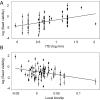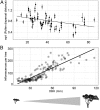Adding landscape genetics and individual traits to the ecosystem function paradigm reveals the importance of species functional breadth
- PMID: 29127217
- PMCID: PMC5715733
- DOI: 10.1073/pnas.1619271114
Adding landscape genetics and individual traits to the ecosystem function paradigm reveals the importance of species functional breadth
Abstract
Animal pollination mediates both reproduction and gene flow for the majority of plant species across the globe. However, past functional studies have focused largely on seed production; although useful, this focus on seed set does not provide information regarding species-specific contributions to pollen-mediated gene flow. Here we quantify pollen dispersal for individual pollinator species across more than 690 ha of tropical forest. Specifically, we examine visitation, seed production, and pollen-dispersal ability for the entire pollinator community of a common tropical tree using a series of individual-based pollinator-exclusion experiments followed by molecular-based fractional paternity analyses. We investigate the effects of pollinator body size, plant size (as a proxy of floral display), local plant density, and local plant kinship on seed production and pollen-dispersal distance. Our results show that while large-bodied pollinators set more seeds per visit, small-bodied bees visited flowers more frequently and were responsible for more than 49% of all long-distance (beyond 1 km) pollen-dispersal events. Thus, despite their size, small-bodied bees play a critical role in facilitating long-distance pollen-mediated gene flow. We also found that both plant size and local plant kinship negatively impact pollen dispersal and seed production. By incorporating genetic and trait-based data into the quantification of pollination services, we highlight the diversity in ecological function mediated by pollinators, the influential role that plant and population attributes play in driving service provision, and the unexpected importance of small-bodied pollinators in the recruitment of plant genetic diversity.
Keywords: bees; body size; ecological services; pollen-mediated gene flow; pollination.
Conflict of interest statement
The authors declare no conflict of interest.
Figures



Similar articles
-
Primary pollinator exclusion has divergent consequences for pollen dispersal and mating in different populations of a bird-pollinated tree.Mol Ecol. 2019 Nov;28(22):4883-4898. doi: 10.1111/mec.15264. Epub 2019 Oct 26. Mol Ecol. 2019. PMID: 31596991
-
Sources of variation in pollinator contribution within a guild: the effects of plant and pollinator factors.Oecologia. 1996 Sep;107(4):595-604. doi: 10.1007/BF00333953. Oecologia. 1996. PMID: 28307405
-
Variation in pollination: causes and consequences for plant reproduction.Am Nat. 2009 Sep;174(3):382-98. doi: 10.1086/603626. Am Nat. 2009. PMID: 19627226
-
Flower visitors and pollination in the Oriental (Indomalayan) Region.Biol Rev Camb Philos Soc. 2004 Aug;79(3):497-532. doi: 10.1017/s1464793103006341. Biol Rev Camb Philos Soc. 2004. PMID: 15366761 Review.
-
Mechanisms and evolution of deceptive pollination in orchids.Biol Rev Camb Philos Soc. 2006 May;81(2):219-35. doi: 10.1017/S1464793105006986. Biol Rev Camb Philos Soc. 2006. PMID: 16677433 Review.
Cited by
-
Untangling biodiversity interactions: A meta network on pollination in Earth's most diverse tropical savanna.Ecol Evol. 2024 Mar 11;14(3):e11094. doi: 10.1002/ece3.11094. eCollection 2024 Mar. Ecol Evol. 2024. PMID: 38476698 Free PMC article.
-
Janzen-Connell effects shape gene flow patterns and realized fitness in the tropical dioecious tree Spondias purpurea (ANACARDIACEAE).Sci Rep. 2020 Mar 12;10(1):4584. doi: 10.1038/s41598-020-61394-4. Sci Rep. 2020. PMID: 32165645 Free PMC article.
-
Population structure in Neotropical plants: Integrating pollination biology, topography and climatic niches.Mol Ecol. 2022 Apr;31(8):2264-2280. doi: 10.1111/mec.16403. Epub 2022 Mar 2. Mol Ecol. 2022. PMID: 35175652 Free PMC article.
-
Interspecific competition in germination of bird-dispersed seeds in a habitat with sparse tree vegetation in South Africa.Bot Stud. 2021 Jun 10;62(1):10. doi: 10.1186/s40529-021-00317-6. Bot Stud. 2021. PMID: 34110534 Free PMC article.
-
Short-distance seed and pollen dispersal in both hunted and intact forests in the lower canopy African rainforest tree, Coula edulis Baill. (Coulaceae).BMC Ecol Evol. 2025 Mar 13;25(1):20. doi: 10.1186/s12862-025-02356-0. BMC Ecol Evol. 2025. PMID: 40075257 Free PMC article.
References
-
- Hassan R, Scholes R, Ash N, editors. Ecosystems and Human Well-Being: Current State and Trends. Vol 1 Island Press; Washington, DC: 2005.
-
- Srivastava DS, Vellend M. Biodiversity-ecosystem function research: Is it relevant to conservation? Annu Rev Ecol Evol Syst. 2005;36:267–294.
-
- Balvanera P, et al. Quantifying the evidence for biodiversity effects on ecosystem functioning and services. Ecol Lett. 2006;9:1146–1156. - PubMed
-
- Mace GM, Norris K, Fitter AH. Biodiversity and ecosystem services: A multilayered relationship. Trends Ecol Evol. 2012;27:19–26. - PubMed
Publication types
MeSH terms
Associated data
LinkOut - more resources
Full Text Sources
Other Literature Sources
Miscellaneous

